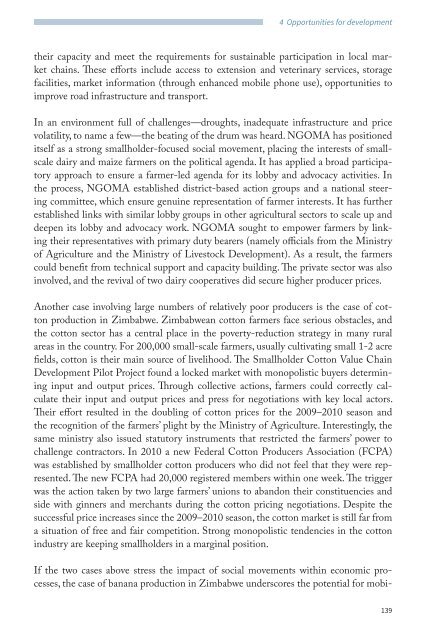Regional Markets
56ec00c44c641_local-markets-book_complete_LR
56ec00c44c641_local-markets-book_complete_LR
You also want an ePaper? Increase the reach of your titles
YUMPU automatically turns print PDFs into web optimized ePapers that Google loves.
4 Opportunities for development<br />
their capacity and meet the requirements for sustainable participation in local market<br />
chains. These efforts include access to extension and veterinary services, storage<br />
facilities, market information (through enhanced mobile phone use), opportunities to<br />
improve road infrastructure and transport.<br />
In an environment full of challenges—droughts, inadequate infrastructure and price<br />
volatility, to name a few—the beating of the drum was heard. NGOMA has positioned<br />
itself as a strong smallholder-focused social movement, placing the interests of smallscale<br />
dairy and maize farmers on the political agenda. It has applied a broad participatory<br />
approach to ensure a farmer-led agenda for its lobby and advocacy activities. In<br />
the process, NGOMA established district-based action groups and a national steering<br />
committee, which ensure genuine representation of farmer interests. It has further<br />
established links with similar lobby groups in other agricultural sectors to scale up and<br />
deepen its lobby and advocacy work. NGOMA sought to empower farmers by linking<br />
their representatives with primary duty bearers (namely officials from the Ministry<br />
of Agriculture and the Ministry of Livestock Development). As a result, the farmers<br />
could benefit from technical support and capacity building. The private sector was also<br />
involved, and the revival of two dairy cooperatives did secure higher producer prices.<br />
Another case involving large numbers of relatively poor producers is the case of cotton<br />
production in Zimbabwe. Zimbabwean cotton farmers face serious obstacles, and<br />
the cotton sector has a central place in the poverty-reduction strategy in many rural<br />
areas in the country. For 200,000 small-scale farmers, usually cultivating small 1-2 acre<br />
fields, cotton is their main source of livelihood. The Smallholder Cotton Value Chain<br />
Development Pilot Project found a locked market with monopolistic buyers determining<br />
input and output prices. Through collective actions, farmers could correctly calculate<br />
their input and output prices and press for negotiations with key local actors.<br />
Their effort resulted in the doubling of cotton prices for the 2009–2010 season and<br />
the recognition of the farmers’ plight by the Ministry of Agriculture. Interestingly, the<br />
same ministry also issued statutory instruments that restricted the farmers’ power to<br />
challenge contractors. In 2010 a new Federal Cotton Producers Association (FCPA)<br />
was established by smallholder cotton producers who did not feel that they were represented.<br />
The new FCPA had 20,000 registered members within one week. The trigger<br />
was the action taken by two large farmers’ unions to abandon their constituencies and<br />
side with ginners and merchants during the cotton pricing negotiations. Despite the<br />
successful price increases since the 2009–2010 season, the cotton market is still far from<br />
a situation of free and fair competition. Strong monopolistic tendencies in the cotton<br />
industry are keeping smallholders in a marginal position.<br />
If the two cases above stress the impact of social movements within economic processes,<br />
the case of banana production in Zimbabwe underscores the potential for mobi-<br />
139


